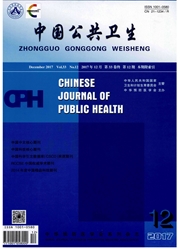

 中文摘要:
中文摘要:
目的观察不同碘摄入水平与正常人群甲状腺疾病之间的关系。方法选择甲状腺功能正常的健康志愿者,年龄为18~24岁。随机分为7组,各组每人每天补充500,750,1000,1250,1500,1750,2000vg的碘剂,为期4周。采用放免法测定血清甲状腺过氧化物酶抗体(TPOAb)、甲状腺球蛋白抗体(TGAb),采用化学发光法测定血清游离T4(FT4),灵敏促甲状腺激素(sTSH)浓度。结果志愿者接受500~2000ug/d的碘剂2周后即出现亚临床甲状腺功能减退的发生。补充500ug/d碘剂量组人群亚临床甲状腺功能减退的发病率较低(15.00%)且随补碘时间的延长发病率稳定不变,除1750ug/a组稍有下降外,其余各组的亚临床甲状腺功能减退的发病率随着补充碘剂时间的延长,人群呈现发病率上升的趋势。发病率在28,00%~47.37%之间。4周后各剂量组未见临床甲状腺功能减退患者。结论甲状腺功能正常的健康人群在短期内摄入包括膳食在内的高剂量碘(840~2340ug),将出现以亚临床甲状腺功能减退为主的功能异常症状。
 英文摘要:
英文摘要:
Objective To observe the relationship between different iodine intake levels and thyroid disease in medical students. Methods Thyroid healthy volunteers whose age was from 18 to 24 years old were recruited and divided into 7 groups randomly, each group was assigned to receive 500,750, 1 000, 1 250, 1 500, 1 750, and 2 000 micrograms iodide oral doses/day for four weeks, respectively. Serum concentration of FT4 and sTSH were measured by chemoluminescence assays. Results Some subjects occurred subclinical hypothyroidism after supplied with 500ug-2000ug iodide oral doses/day for 2 weeks. Compared with the other groups, subjects with a 500ug/d iodine oral dose had a lower incidence (15.00%) of subclinical hypothyroidism and the incidence was steady along with time of iodine supplement. The incidence slightly decreased in the group with 1 750ug/d iodine oral intake after 4 weeks. Subclinical hypothyroidism incidences of the rest groups represented an ascending trend along with iodine supplement and were in the rang of 28.00 % - 47.37 %. No subclinical hypothyroidism case was detected after 4 weeks in all groups. Conclusion The dysfunction of thyroid in normal population was mainly subclinical hypothyroidism with an exposure to a high dose of iodine intake (840ug--2 340ug) during a short period.
 同期刊论文项目
同期刊论文项目
 同项目期刊论文
同项目期刊论文
 期刊信息
期刊信息
